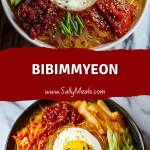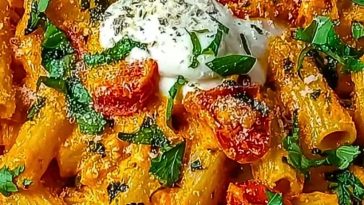If there’s one dish I find myself craving every time the weather heats up, it’s bibimmyeon. This vibrant bowl of Korean spicy cold noodles is refreshingly cool, delightfully spicy, and so simple to pull together that it practically begs to be a go-to for quick lunches or light dinners. It’s one of those meals where every bite wakes up your palate — the chewiness of the noodles, the zing of gochujang-based sauce, and the crisp freshness of cucumber and scallions make it a perfectly balanced experience.
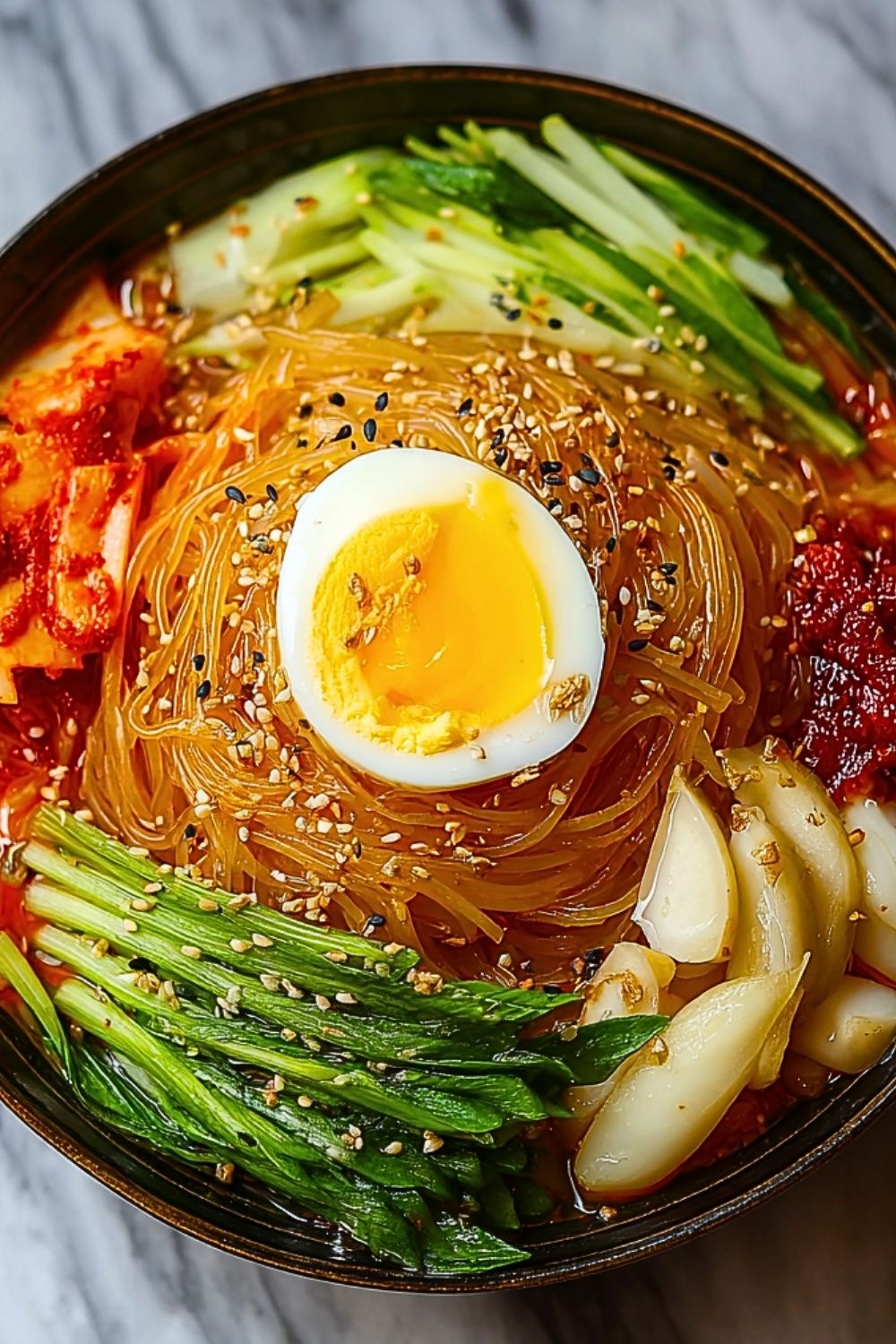
What I love most about bibimmyeon is how effortlessly customizable it is. Some days I keep it minimal with just a soft-boiled egg on top. Other times, I’ll load it up with crunchy vegetables and a spoonful of kimchi for that extra kick. The contrast of cold noodles coated in spicy-sweet sauce against cool toppings makes it addictively good. Once you try it, I promise it’ll earn a permanent spot in your easy recipe rotation.
Why You’ll Love This Bibimmyeon Recipe
This recipe comes together in 15 minutes or less, making it ideal for busy weeknights or lazy weekends. It’s light yet satisfying, and the spicy-sweet-tangy sauce is utterly crave-worthy. Perfect for warm weather, and endlessly adaptable for vegan, vegetarian, or protein-packed versions. Plus, it requires zero special equipment.
What Kind of Noodles Should I Use for Bibimmyeon?
Traditionally, bibimmyeon is made with “somyeon” (thin wheat flour noodles), which cook quickly and hold onto the sauce beautifully. However, you can substitute with soba noodles, rice vermicelli, or even ramen noodles in a pinch. The key is to keep them chewy and rinse them in cold water immediately to stop the cooking.
Options for Substitutions
- Noodles: Swap somyeon with soba, ramen, or gluten-free rice noodles.
- Gochujang: If you can’t find Korean chili paste, try mixing miso with chili flakes or sriracha for a similar umami-spicy flavor.
- Sweetener: Sugar is standard, but honey, agave, or even a splash of fruit juice work well.
- Vegetables: Use what you have! Carrots, red cabbage, bell peppers, or lettuce all bring great crunch.
- Protein: Add tofu, boiled egg, grilled chicken, or canned tuna for a protein boost.
Ingredients for This Bibimmyeon Recipe
- Somyeon (Thin Wheat Noodles): These Korean wheat noodles are quick-cooking and have the ideal chewy texture to hold the sauce.
- Gochujang (Korean Chili Paste): The star of the sauce — it brings heat, depth, and a signature Korean flavor.
- Gochugaru (Korean Red Chili Flakes): Adds a smoky, earthy kick to intensify the spiciness.
- Soy Sauce: Balances the sauce with umami saltiness.
- Sesame Oil: A drizzle of nutty richness that enhances aroma and flavor.
- Rice Vinegar: Provides tanginess to balance the spicy-sweet base.
- Sugar: Softens the heat and rounds out the flavors.
- Garlic (minced): Fresh garlic elevates the sauce with sharp pungency.
- Cucumber (julienned): Cool, crisp contrast to the heat of the noodles.
- Scallions (sliced thin): Adds a fresh bite and slight sweetness.
- Hard or Soft-Boiled Egg: A creamy, mild topping that helps mellow the spice.
- Sesame Seeds: For extra crunch and a toasty finish.
- Kimchi or Pickled Radish (optional): Bonus zing for fermentation lovers.
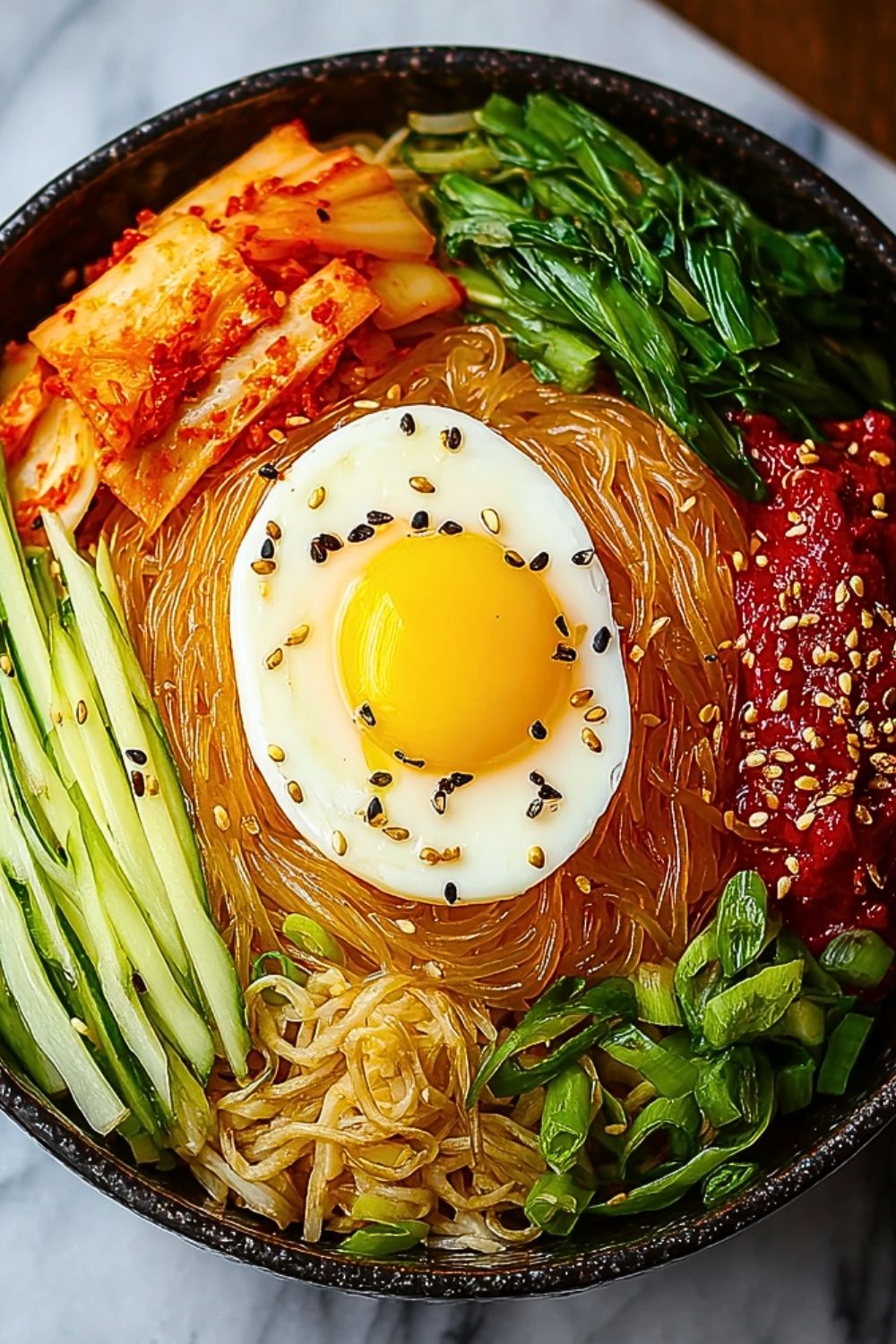
Step 1: Cook the Noodles
Boil the somyeon noodles according to package directions, usually about 3–4 minutes. Stir occasionally to prevent sticking. Once cooked, rinse thoroughly under cold running water to stop cooking and remove excess starch. Drain completely.
Step 2: Make the Spicy Sauce
In a mixing bowl, combine 2 tablespoons gochujang, 1 tablespoon gochugaru, 1 tablespoon soy sauce, 2 teaspoons sesame oil, 1 tablespoon sugar, 1 tablespoon rice vinegar, and 1 minced garlic clove. Mix until smooth. Taste and adjust for sweetness or heat.
Step 3: Toss the Noodles
Place the cold noodles in a large mixing bowl. Add the spicy sauce and toss well until every strand is evenly coated. Use chopsticks or tongs for better control.
Step 4: Prepare the Toppings
While the noodles sit in the sauce, slice cucumber and scallions thinly. Boil an egg to your preferred doneness (6–7 minutes for soft-boiled, 9–10 for hard-boiled). You can also prep kimchi or any extra veggies you’d like.
Step 5: Assemble Your Bibimmyeon Bowl
Transfer the sauced noodles to a serving bowl. Neatly arrange cucumber, scallions, and kimchi (if using) around the edges. Place halved egg on top, sprinkle with sesame seeds, and add extra sauce if desired.
Step 6: Serve and Enjoy Immediately
Bibimmyeon is best enjoyed fresh and cold. Mix the toppings in just before eating for a full bite of flavor in every mouthful. Add more vinegar or sesame oil to suit your taste.
How Long to Prepare the Bibimmyeon Recipe
Prep Time: Most of your prep time will go into slicing vegetables and boiling the egg. This usually takes about 10 minutes. While the noodles boil, you can multitask by preparing the sauce and chopping your toppings.
Cooking Time: The somyeon noodles cook in just 3–4 minutes. The egg can boil simultaneously, so the total active time stays around 15 minutes.
Altogether, this makes Bibimmyeon a perfect quick meal for when you’re short on time but still want something bold and satisfying.
Tips for Perfect Bibimmyeon
- Always rinse noodles under cold water until completely cool to maintain their chewy texture.
- Let the sauce sit for a few minutes before mixing to allow the flavors to meld.
- Chill your serving bowls briefly before plating for a super-refreshing experience.
- For more depth, add a dash of fish sauce or finely grated onion to the sauce.
- Adjust spice levels by reducing or increasing gochugaru and gochujang as preferred.
Watch Out for These Mistakes While Cooking
- Overcooking the noodles: They become too soft and don’t hold up under the sauce.
- Not rinsing noodles: Skipping the cold rinse leads to gummy texture.
- Using too much sauce: It can overpower the delicate balance — start with less and add more as needed.
- Ignoring freshness of vegetables: Wilted cucumbers or scallions dull the overall dish.
- Serving warm: This dish is meant to be cold — warm noodles or sauce throw off the flavor and texture.
What to Serve With Bibimmyeon?
1. Korean Fried Chicken
Crispy, juicy, and often spicy — the ultimate pairing for these cool noodles.
2. Mandoo (Korean Dumplings)
Steamed or pan-fried dumplings add a savory bite that complements the noodles perfectly.
3. Seaweed Salad
A light and salty seaweed salad makes a great palate cleanser and adds a refreshing ocean note.
4. Pickled Radish (Danmuji)
Sweet, tangy, and crunchy — this Korean staple cuts through the heat of the sauce.
5. Kimchi Pancakes
Crispy, slightly sour pancakes made with fermented kimchi round out a Korean meal beautifully.
Storage Instructions
Storing the Noodles: If you plan to store leftover bibimmyeon, keep the sauce and noodles separate to prevent them from getting soggy. Rinse the noodles again with cold water before eating if they’ve been refrigerated.
Sauce Storage: The sauce can be made ahead and stored in an airtight container in the fridge for up to 1 week. Stir well before using again.
Egg and Toppings: Hard-boiled eggs can be prepped a day ahead. Keep cut vegetables fresh by storing them in cold water in the fridge.
Estimated Nutrition (Per Serving)
- Calories: 390 kcal
- Protein: 11g
- Carbohydrates: 55g
- Fat: 13g
- Saturated Fat: 2g
- Cholesterol: 90mg
- Sodium: 720mg
- Fiber: 3g
- Sugar: 7g
Frequently Asked Questions
Can I make Bibimmyeon vegan?
Yes! Just skip the egg and ensure your gochujang is vegan. Add tofu or tempeh for protein.
What if I can’t find gochujang?
You can substitute with a mix of miso, chili flakes, and a touch of soy sauce or sriracha to mimic the flavor.
Can I make it less spicy?
Absolutely. Reduce the amount of gochugaru or use a mild chili paste instead. You can also add more sugar or vinegar to balance the heat.
Do I have to use Korean noodles?
No. While somyeon is traditional, soba, rice noodles, or even angel hair pasta can work.
Is Bibimmyeon eaten only in summer?
While it’s especially popular in summer, there’s no rule — it’s great all year round as a quick and flavorful cold meal.
Conclusion
Bibimmyeon is the ultimate fusion of fiery spice, chilled textures, and Korean comfort food simplicity. Whether you’re diving into Korean cuisine for the first time or just want a quick, satisfying meal that packs a punch, this dish delivers every time. It’s fast, flexible, and bursting with personality — the kind of recipe you’ll come back to again and again, no matter the season.
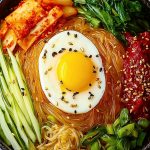
Bibimmyeon
- Prep Time: 10 minutes
- Cook Time: 5 minutes
- Total Time: 15 minutes
- Yield: 2 servings 1x
- Category: Main Course
- Method: No-Cook/Boil
- Cuisine: Korean
- Diet: Vegetarian
Description
Looking for a quick and flavorful meal that’s bold, refreshing, and full of Korean flair? Bibimmyeon — or Korean spicy cold noodles — is your answer. This easy recipe combines chewy cold noodles with a sweet, tangy, and fiery gochujang sauce, topped with crisp veggies and a creamy egg. Whether you’re hunting for new dinner ideas, a quick lunch, or an easy recipe for hot days, this dish delivers big flavor in under 15 minutes. It’s one of the most satisfying food ideas when you want something fast, delicious, and energizing. Perfect for anyone exploring Korean cuisine or looking for vibrant breakfast ideas or healthy snack alternatives too.
Ingredients
2 servings somyeon (thin Korean wheat noodles)
2 tablespoons gochujang (Korean chili paste)
1 tablespoon gochugaru (Korean red chili flakes)
1 tablespoon soy sauce
2 teaspoons sesame oil
1 tablespoon sugar
1 tablespoon rice vinegar
1 clove garlic, minced
1 cucumber, julienned
2 scallions, thinly sliced
2 eggs, soft or hard-boiled
1 tablespoon sesame seeds
1/4 cup kimchi or pickled radish (optional)
Instructions
1. Boil the somyeon noodles according to package instructions (about 3–4 minutes). Stir to prevent clumping.
2. Immediately rinse the noodles under cold running water until fully cooled. Drain well.
3. In a bowl, mix gochujang, gochugaru, soy sauce, sesame oil, sugar, rice vinegar, and minced garlic. Stir until smooth.
4. Place cooled noodles in a mixing bowl. Add sauce and toss well to coat all noodles evenly.
5. While the noodles sit in sauce, prepare your toppings: slice cucumber and scallions, and boil the egg to desired doneness.
6. Transfer noodles to a serving bowl. Arrange cucumber, scallions, and optional kimchi or radish around the edge.
7. Place halved egg on top and sprinkle with sesame seeds. Add more sauce or sesame oil if preferred.
8. Serve immediately while cold and fresh. Mix everything together before eating.
Notes
Always rinse the noodles thoroughly in cold water to keep them chewy and prevent stickiness.
Chill your bowls before plating to enhance the cooling experience.
You can adjust the sauce’s spice level by tweaking the amount of gochujang and gochugaru.
Nutrition
- Serving Size: 1 bowl
- Calories: 390
- Sugar: 7g
- Sodium: 720mg
- Fat: 13g
- Saturated Fat: 2g
- Unsaturated Fat: 9g
- Trans Fat: 0g
- Carbohydrates: 55g
- Fiber: 3g
- Protein: 11g
- Cholesterol: 90mg

